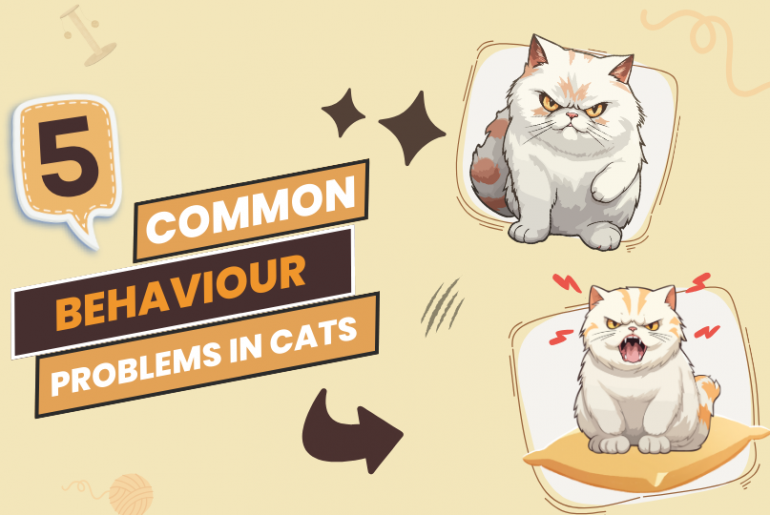There’s an old saying that goes, A cat’s a cat, and that’s that. While cats are definitely adorable and interesting pets, they are also mysterious and unpredictable, all at the same time. If you are a cat parent, you must already know how fussy these four-legged deities can get.
Whether it’s suddenly boycotting the litter box, marking urine scent on the furniture, or scratching the furniture to shreds, cats can exhibit a range of behavior problems that can leave you devastated. Understanding their common behavior problems can be helpful in maintaining a harmonious relationship with your feline companion.
This blog explains five of the most common cat behavioral problems along with their respective reasons and solutions. Read through to know more.
Why Do Cats Get Behavioral Problems?
There is no singular reason why cats develop behavioral problems. It can be challenging to understand exactly why your cat is behaving the way it is. However, it can be related to their health, stress, boredom, or just environmental changes. Sometimes the uncommon behavior can be a unique personality of your cat, while other times your cat may be trying to indicate something. It’s important to identify the underlying cause of your cat’s behavioral problems in order to address them effectively.
What Are The Common Behavior Problems In Cats?
Each cat has a unique identity, meaning that their behavioral problems can vary. However, there are some common behavioral problems that many cats experience. Here are some of them:
1. Boycotting Litter Box

Cats usually use litter boxes for both urination and defecation. And they can be easily trained for this habit. However, sometimes cats may develop elimination problems and start boycotting the litter box. This may not seem like a problem at first, but it can turn chronic if not addressed properly. Once cats start avoiding litter boxes, they will soon start looking for another location or surface for elimination, which can be your porch or a sitting chair.
Possible Reasons For Avoiding Litter Box
Your cat may start avoiding the litter box due to various reasons. It could be because:
- The litter box isn’t clean.
- The litter box is too small for your cat.
- There are not enough litter boxes.
- Your cat doesn’t like the smell of litter.
- The litter box is not in your cat’s preferred location.
- Your cat is unable to use the litter box.
- Your cat is stressed due to your home environment or events.
- Your cat is having a conflict with another cat in your house.
- Your cat has a medical ailment: a urinary tract infection, kidney stones, blockage, feline interstitial cystitis, etc.
Solutions To Resolve This Issue
There are various solutions to resolve this issue. It includes:
- Get a larger litter box for your cat.
- Regularly clean and fill the litter in the box.
- Provide multiple litter boxes if you have multiple cats.
- Consider unscented litter options.
- Place the litter box in your cat’s preferred location.
- Spray odor neutralizers where you place the litter tray.
- You can use feline pheromone spray or diffusers.
- Maintain a consistent feeding schedule to prevent stress for your cat.
- Do not shout when your cat is using the litter box.
- Play with your cats; this will help dissolve their conflicts.
- Consult your vet if your cat continues to avoid litter boxes.
2. Excessive Meowing and Yowling
 Cats meow to communicate. Adult cats usually don’t meow much. Also, cats mostly meow for humans rather than for other cats. Kittens meow to communicate with their mother, and this stops when they are adults. Yowling is similar to meowing, but more melodic and intense. Cats usually yowl at one another, especially during the breeding season. However, if your cat has suddenly started excessively meowing or yowling, it can become a problem.
Cats meow to communicate. Adult cats usually don’t meow much. Also, cats mostly meow for humans rather than for other cats. Kittens meow to communicate with their mother, and this stops when they are adults. Yowling is similar to meowing, but more melodic and intense. Cats usually yowl at one another, especially during the breeding season. However, if your cat has suddenly started excessively meowing or yowling, it can become a problem.
Possible Reasons for Excessive Meowing and Yowling
There can be various reasons why your cat is excessively meowing or yowling. It could be:
- Your cat is asking for food.
- Your cat wants to go out.
- Your cat is seeking your attention.
- Your cat is confused.
- Your cat is bored.
- Your cat is in pain or discomfort.
- Your cat may have some medical issues.
Solutions To Resolve This Issue
There are many ways to reduce vocalization in your cat. It includes:
- Don’t give any attention to your cat when they cry.
- Don’t feed your cat when they cry.
- Break your cat’s daily food allotment into multiple small parts and feed them throughout the day to prevent hunger-induced meowing.
- Provide interactive toys and playtime to keep your cat mentally stimulated and entertained.
- Ensure that your cat has a comfortable and relaxing environment with scratching posts, hiding spots, and perches.
- Consult a vet if the excessive vocalization persists.
3. Destructive Scratching
 All cats scratch. It’s their normal behavior. Cats scratch to sharpen their claws as well as to mark their territory. However, destructive scratching can be a problem when it damages furniture or other valuable items in your home.
All cats scratch. It’s their normal behavior. Cats scratch to sharpen their claws as well as to mark their territory. However, destructive scratching can be a problem when it damages furniture or other valuable items in your home.
Possible Reasons for Destructive Scratching
Though scratching is a natural behavior for cats, they exhibit destructive scratching due to:
- They want to sharpen their claws.
- They are marking their territory.
- Your cat is bored.
- Your cat wants to threaten other cats.
Solutions To Resolve This Issue
You can consider the following tips to prevent destructive scratching in your cat:
- Put different types of scratching posts in your home.
- Spray catnip on the scratching posts.
- Use repellent sprays on the surfaces you don’t want your cats to scratch.
- Use nail caps.
- Clip your cat’s nail frequently.
[Also Read] Cat Declawing and It’s Alternative
4. Urine Spraying and Marking
 Urine marking is a common behavioral problem faced by many cat parents. Cats tend to spray their urine on vertical surfaces, furniture, curtains, and other objects. Mostly exhibited by male cats, urine spraying is a part of territorial marking. It is important to note that urine spraying and marking can also be exhibited by female cats.
Urine marking is a common behavioral problem faced by many cat parents. Cats tend to spray their urine on vertical surfaces, furniture, curtains, and other objects. Mostly exhibited by male cats, urine spraying is a part of territorial marking. It is important to note that urine spraying and marking can also be exhibited by female cats.
Possible Reasons for Urine Spraying
There are many possible reasons for urine spraying in cats. It includes:
- Cats mark urine to communicate with other cats.
- Cats also mark their urine when they are ready to breed.
- Your cat may be avoiding litter boxes.
- Your cat is having a conflict with other cats in your home.
- Your cat is experiencing stress or anxiety, such as changes in the cat’s environment or routine.
- Your cat may have medical issues, such as a UTI or bladder problem.
Solutions To Resolve This Issue
It’s important to identify the root cause of urine markings to better address the issue. You may consider the following tips:
- Provide more litter boxes for your cat.
- Neutering or spaying your cat will reduce markings related to breeding.
- Provide multiple perching areas; this will help avoid multi-cat household conflicts.
- Play with your cat and keep them engaged.
- Playing with your cats also helps resolve conflicts.
- Do not throw things at your cat when marking.
- Consult a vet if the marking persists; this may be a medical condition.
5. Aggression
 While most cats are fussy, they don’t typically display aggressive behavior unless provoked or threatened. They may bite or scratch you or your other pet during their playtime, but it’s only playful. However, if your cat is displaying excessive aggression, it can be a problem. It can be potentially harmful when an aggressive cat is approached or handled by humans or other animals. It’s important to understand the underlying cause of the aggression and address it accordingly.
While most cats are fussy, they don’t typically display aggressive behavior unless provoked or threatened. They may bite or scratch you or your other pet during their playtime, but it’s only playful. However, if your cat is displaying excessive aggression, it can be a problem. It can be potentially harmful when an aggressive cat is approached or handled by humans or other animals. It’s important to understand the underlying cause of the aggression and address it accordingly.
Possible Reasons for Aggression
There are many reasons why cats may show excessive aggression. This includes:
- Your cat is over stimulated.
- Your cat is playing aggressively.
- Your cat is guarding food, territory, or a toy.
- Your cat is threatened and frightened.
- Your cat is feeling uncomfortable and uneasy.
- Your cat is in conflict with other felines.
Solutions To Resolve This Issue
Some of the effective ways to prevent aggressive cat behaviors include the following:
- Train your cat to repeat good behavior.
- Make a loud noise (clapping hands) when they are angry to deviate them.
- Avoid doing things that trigger or irritate your cat.
- Do not punish your cat.
- Seek help from a professional if the aggression persists.
Bottom Line: Start Early
Behavioral problems can be more easily managed in kittens than in adult cats. It’s important to start working with your cat at a young age and manage behavioral problems as early as possible. Starting early will help you prevent the behavior from becoming ingrained, which may become more difficult to manage in the future. Additionally, early intervention can help create a positive and harmonious environment for both you and your cat.





